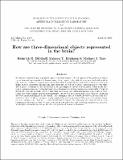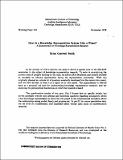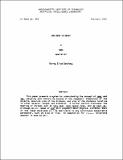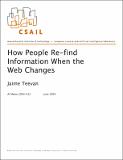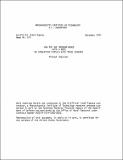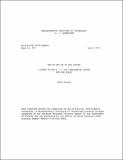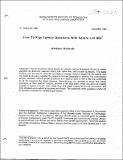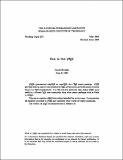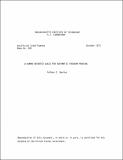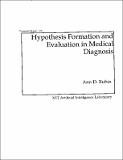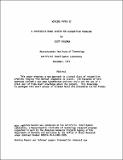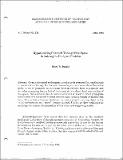Browsing Artificial Intelligence Lab Publications by Title
Now showing items 681-700 of 1835
-
How are Three-Deminsional Objects Represented in the Brain?
(1994-04-01)We discuss a variety of object recognition experiments in which human subjects were presented with realistically rendered images of computer-generated three-dimensional objects, with tight control over stimulus shape, ... -
How do Humans Determine Reflectance Properties under Unknown Illumination?
(2001-10-21)Under normal viewing conditions, humans find it easy to distinguish between objects made out of different materials such as plastic, metal, or paper. Untextured materials such as these have different surface reflectance ... -
How Is a Knowledge Representation System Like a Piano?
(MIT Artificial Intelligence Laboratory, 1978-11)In the summer of 1978 a decision was made to devote a special issue of the SIGART newsletter to the subject of knowledge representation research. To assist in ascertaining the current state of people's thinking on this ... -
How Near is Near?
(1976-02-01)This paper presents a system for understanding the concept of near and far, weighing such factors as purpose of the judgement, dimensions of the objects, absolute size of the distance, and size of the distance relative ... -
How People Execute Handwriting
(MIT Artificial Intelligence Laboratory, 1975-07)Handwriting is shown to be composed mainly of cup-shaped strokes lasting approximately 200 msec. The strokes are based on a hexagonal pattern, with quantized slopes and lengths. Each side of the hexagon is produced by a ... -
How People Re-find Information When the Web Changes
(2004-06-18)This paper investigates how people return to information in a dynamic information environment. For example, a person might want to return to Web content via a link encountered earlier on a Web page, only to learn that the ... -
How the GAS Program Works with a Note on Simulating Turtles with Touch Sensors
(1972-12-01)The GAS program is a display simulation of a 2 dimensional ideal gas. Barriers, or walls, are line segments, and molecules, alias particles or balls, are circles. Collisions occur between balls and other balls as well ... -
How to do Research At the MIT AI Lab
(MIT Artificial Intelligence Laboratory, 1988-10)This document presumptuously purports to explain how to do research. We give heuristics that may be useful in pickup up specific skills needed for research (reading, writing, programming) and for understanding and enjoying ... -
How to Do the Right Thing
(1989-10-01)This paper presents a novel approach to the problem of action selection for an autonomous agent. An agent is viewed as a collection of competence modules. Action selection is modeled as an emergent property of an ... -
How to Get onto the System
(1971-04-01)This memo is intended to get very new users started on the MAC AI system. It presents some simple rituals for making and editing fields, getting print outs, making microtapes, and so on. Most of the rituals given are not ... -
How to Play Twenty Questions with Nature and Win
(1982-12-01)The 20 Questions Game played by children has an impressive record of rapidly guessing an arbitrarily selected object with rather few, well-chosen questions. This same strategy can be used to drive the perceptual process, ... -
How to Use .VSCAN
(MIT Artificial Intelligence Laboratory, 1971-03) -
How to Use YTEX
(MIT Artificial Intelligence Laboratory, 1986-06-09)YTEX—pronounced why-TEX or oops-TEX—is a TEX macro package. YTEX provides both an easy-to-use interface for TEX novices and a powerful macro-creation library for TEX programmers. It is this two-tier structure that makes ... -
A Human Oriented Logic for Automatic Theorem Proving
(1972-10-01)The automation of first order logic has received comparatively little attention from researcher intent upon synthesizing the theorem proving mechanism used by humans. The dominant point of view [15], [18] has been that ... -
Hypergeometric Functions in MATHLAB
(1970-06-01)This memo describers some of the important properties and manipulations of Hypergeometric Functions which my be useful in MATHLAB. A convention for representing the function is adopted which is readily adaptable to ... -
Hypothesis Formation and Evaluation in Medical Diagnosis
(1975-01-01)This thesis describes some aspects of a computer system for doing medical diagnosis in the specialized field of kidney disease. Because such a system faces the spectre of combinatorial explosion, this discussion concentrates ... -
An Hypothesis-Driven Recognition System for the Blocks World
(MIT Artificial Intelligence Laboratory, 1974-03)This paper presents a visual recognition program in which recognition process is driven by hypotheses about the object being recognized. The hypothesis suggests which features to examine next, refines its predictions based ... -
A Hypothesis-Frame System for Recognition Problems
(MIT Artificial Intelligence Laboratory, 1973-12)This paper proposes a new approach to a broad class of recognition problems ranging from medical diagnosis to vision. The features of this approach include a top-down hypothesize-and-test style and the use of a great deal ... -
Hypothesizing and Refining Causal Models
(1984-12-01)An important common sense competence is the ability to hypothesize causal relations. This paper presents a set of constraints which make the problem of formulating causal hypotheses about simple physical systems a ... -
Hypothesizing Channels through Free-Space in Solving the Findpath Problem
(1983-06-01)Given a polyhedral environment, a technique is presented for hypothesizing a channel volume through the free space containing a class of successful collision-free paths. A set of geometric constructions between obstacle ...

